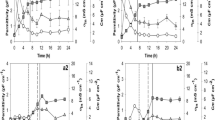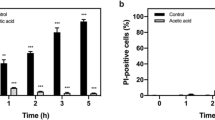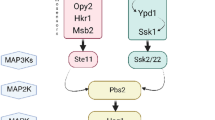Abstract
It is considered that all growing cells, for exception of acidophilic bacteria, have negatively charged inside cytoplasmic membrane (Δψ− - cells). Here we show that growing populations of microbial cells contain a small portion of cells with positively charged inside cytoplasmic membrane (Δψ+ - cells). These cells were detected after simultaneous application of the fluorescent probes for positive membrane potential (anionic dye DIBAC-) and membrane integrity (propidium iodide, PI). We found in exponentially growing cell populations of Escherichia coli and Saccharomyces cerevisiae that the content of live Δψ- - cells was 93.6 ± 1.8 % for bacteria and 90.4 ± 4.0 % for yeasts and the content of live Δψ+ - cells was 0.9 ± 0.3 % for bacteria and 2.4 ± 0.7 % for yeasts. Hypothetically, existence of Δψ+ - cells could be due to short-term, about 1 min for bacteria and 5 min for yeasts, change of membrane potential from negative to positive value during the cell cycle. This change has been shown by the reversions of K+, Na+, and Ca2+ ions fluxes across the cell membrane during synchronous yeast culture. The transformation of Δψ-- cells to Δψ+ - cells can be explained by slow influx of K+ ions into Δψ-- cell to the trigger level of K+ concentration (“compression of potassium spring”), which is forming “alternative” Δψ+-cell for a short period, following with fast efflux of K+ ions out of Δψ+-cell (“release of potassium spring”) returning cell to normal Δψ- state. We anticipate our results to be a starting point to reveal the biological role of cell dualism in form of Δψ- - and Δψ+ - cells.
Similar content being viewed by others
References
Alberghina L, Mavelli G, Drovandi G, Palumbo P, Pessina S, Tripodi F, Coccetti P, Vanoni M (2012) Cell growth and cell cycle in Saccharomyces cerevisiae: basic regulatory design and protein–protein interaction network. Biotechnol Adv 30:52–72
Arino J, Ramos J, Sychrova H (2010) Alkali metal cation transport and homeostasis in yeasts. Microbiol Mol Biol Rev 74:95–120
Averhoff B (2004) DNA transport and natural transformation in mesophilic and thermophilic bacteria. J Bioenerg Biomembr 36:25–33
Berney M, Hammes F, Bosshard F, Weilnmann HU, Eglii T (2007) Assessment and interpretation of bacterial viability by using the LIVE/DEAD BacLight kit in combination flow cytometry. Appl Environ Microbiol 73:3283–3290
Biondi EG, Reisinger SJ, Skerker JM, Arif M, Perchuk BS, Ryan KR, Laub MT (2006) Regulation of the bacterial cell cycle by an integrated genetic circuit. Nature 444:899–904
Blackiston DJ, McLaughlin KA, Levin M (2009) Bioelectric controls of cell proliferation: ion channels, membrane voltage and the cell cycle. Cell Cycle 8:3527–3536
Boonstra J, Mummery CL, Tertoolen LGJ, Van Der Saag PT, De Laat SW (1981) Cation transport and growth regulation in neuroblastoma cells. Modulations of K+ transport and electrical membrane properties during the cell cycle. J Cell Physiol 107:75–83
Breeuwer P, Abee T (2004) Assessment of the membrane potential, intracellular pH and respiration of bacteria employing fluorescence techniques. In: Kowalchuk GA (ed) Molecular microbial ecology manual, 2nd ed., Kluwer Academic Publishers, The Netherlands, pp. 1563–1580
Cho RJ, Campbell MJ, Winzeler EA, Steinmetz L, Conway A, Wodicka L, Wolfsberg TG, Gabrielian AE (1998) A genome-wide transcriptional analysis of the mitotic cell cycle. Mol Cell 2:65–73
Coudreuse D, Nurse P (2010) Driving the cell cycle with a minimal CDK control network. Nature 468:1074–1079
Haase SB, Reed SI (1999) Evidence that a free-running oscillator drives G1 events in the budding yeast cell cycle. Nature 401:394–397
Ivanov V (2010) Environmental microbiology for engineers. CRC Press, Francis and Taylor Group, Boca Raton, 422 pp
Lopez-Amoros R, Castel S, Comas-Riu J, Vives-Rego J (1997) Assessment of E. coli and Salmonella viability and starvation by confocal laser microscopy and flow cytometery using Rhodamine 123, DiBAC4(3), Propidium Iodide, and CTC. Cytometry 29:298–305
Morgan DO (2007) The cell cycle, principles of control. New Science Press Ltd., London, 297 pp
Manukyan A, Abraham L, Dungrawala H, Schneider BL (2011) Synchronization of yeast. Methods Mol Biol 761:173–200
Muller S, Nebe-von-Caron G (2010) Functional single-cell analyses: flow cytometry and cell sorting of microbial populations and communities. FEMS Microbiol Rev 34:554–587
Nebe-von-Caron G, Stephens PJ, Hewitt CJ, Powell JR, Badley RA (2000) Analysis of bacterial function by multi-colour fluorescence flow cytometry and single cell sorting. J Microbiol Methods 42:97–114
Orlando DA, Lin CY, Bernard A, Wang JY, Socolar JE, Iversen ES, Hartemink AJ, Haase SB (2008) Global control of cell-cycle transcription by coupled CDK and network oscillators. Nature 453:944–947
Pena A, Sanchez NS, Calahorra M (2010) Estimation of the electric plasma membrane potential difference in yeast with fluorescent dyes: comparative study of methods. J Bioenerg Biomembr 42:419–432
Quiros C, Herrero M, Garcia LA, Diaz M (2007) Application of flow cytometry to segregated kinetic modelling based on the physiological states of microorganisms. Appl Environ Microbiol 73:3993–4000
Shapiro HM (2008) Flow cytometry of bacterial membrane potential and permeability. Methods Mol Med 142:175–186
Skerker JM, Laub MT (2004) Cell-cycle progression and the generation of asymmetry in Caulobacter crescentus. Nat Rev Microbiol 2:325–337
Slonczewski JL, Fujisawa M, Dopson M, Krulwich TA (2009) Cytoplasmic pH measurement and homeostasis in Bacteria and Archaea. Adv Microb Physiol 55:1–79
Strahl H, Hamoen LW (2010) Membrane potential is important for bacterial cell division. Proc Natl Acad Sci USA 107:12281–12286
Sundelacruz S, Levin M, Kaplan DL (2009) Role of membrane potential in the regulation of cell proliferation and differentiation. Stem Cell Rev Reports 5:231–246
Wonderlin WF, Woodfork KA, Strobl JS (1995) Changes in membrane potential during the progression of MCF-7 human mammary tumor cells through the cell cycle. J Cell Physiol 165:177–185
Author information
Authors and Affiliations
Corresponding author
Rights and permissions
About this article
Cite this article
Ivanov, V., Rezaeinejad, S. & Chu, J. Cell dualism: presence of cells with alternative membrane potentials in growing populations of bacteria and yeasts. J Bioenerg Biomembr 45, 505–510 (2013). https://doi.org/10.1007/s10863-013-9515-y
Received:
Accepted:
Published:
Issue Date:
DOI: https://doi.org/10.1007/s10863-013-9515-y




